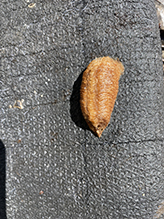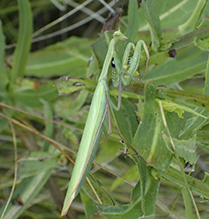European mantis
(Mantis religiosa)
Conservation • Description • Habitat • Ecology • Distribution • Taxonomy
|
|
||||||||||||||
Description |
European mantis is a large, exotic, predaceous insect. It is native to Europe, Asia, and Africa. It was accidentally introduced into North America on nursery stock in 1899. In the 1930s, egg cases were imported and sold both as pest control for garden insects and as biological control of the spongy moth, then called the gypsy moth, in the eastern United States. The egg cases are still commonly sold today as a control for garden pests. European mantis now occurs across the United States and southern Canada, but it is mostly absent from the Midwest and the southeast. It is uncommon in Minnesota. It is often found in urban areas, including gardens, but it prefers natural areas with tall grass and dry bushes, including shrublands, savannas, pastures, meadows, and grasslands. Adult females are 2¾″ to 3½″ (7 to 9 cm) in length, including the wings, which extend beyond the tip of the abdomen. Males are smaller, 2⅜″ to 2¾″ (6 to 7 cm) in length. The body is greatly elongated. The color may be green, yellow, or brown. Studies have shown that the larva can change color many times in its lifetime to correspond to the color of the substrate (foliage) that it is on. The adult takes on the color of the larvae after molting. Adults do not change color. The head is triangular. There are two very large compound eyes and three small simple eyes (ocelli). The compound eyes are on the front of the head, are bulging, and are directed forward. The ocelli are between and above the antennae bases. The antennae are short, thin, and thread-like. They are longer on the male than on the female. The head can be swiveled 180°, allowing the mantis to look “over its shoulder.” The first section of the thorax (prothorax) is greatly elongated. The forewings (tegmen) are mostly thin, pliable, and somewhat transparent (membranous). They may be green, brown, or yellow. The hindwings are clear and are much broadened from front to rear. The front legs are adapted for seizing prey (raptorial). On each front leg the first segment (coxa) is greatly lengthened, and there is a large, oval spot near the base. The spot may have a white center, or it may be entirely black. The third and fourth segments (femur and tibia respectively) are armed with spines. The tibia is less than half as long as the femur. It has several teeth on the underside and no teeth on the upper side. The last part of the leg (tarsus), corresponding to the foot, has five segments. The middle and hind legs are long and slender. |
Size |
Female total length: 2¾″ to 3½″ (7 to 9 cm) Male total length: 2⅜″ to 2¾″ (6 to 7 cm) |
Similar Species |
|
Habitat |
Shrublands, savannas, pastures, meadows, grasslands, and gardens |
Ecology |
Season |
July to October |
Behavior |
Adults are active during the day. They are ambush predators, remaining stationary with their legs raised up as they wait for prey. Females are too large and heavy to fly. In 1992, a study was made of sexual cannibalism in Mantis religiosa in the wild. It found that 31% of the females would kill and eat their mate before, during, or after copulation. Once copulation began, the headless male would complete the process. |
Life Cycle |
In the south, adults are active year round. In the north, adults do not survive the winter, and egg cases (ootheca) overwinter. |
Nymph Food |
Insects. Nymphs are carnivorous when crowded together. |
Adult Food |
Insects, including caterpillars, butterflies, and moths |
Distribution |
||
|
Sources |
|
| 10/11/2024 | ||
Occurrence |
||
|
||
Taxonomy |
|
Order |
Mantodea (mantises) |
Suborder |
Eumantodea (extant mantises) |
Infraorder |
Schizomantodea |
Superfamily |
Mantoidea |
Family |
Mantidae (mantids) |
Subfamily |
Mantinae |
Tribe |
Mantini |
Genus |
Mantis |
Subordinate Taxa |
|
European mantis (Mantis religiosa beybienkoi) European mantis (Mantis religiosa caucasica) European mantis (Mantis religiosa eichleri) European mantis (Mantis religiosa inornata) European mantis (Mantis religiosa langoalata) European mantis (Mantis religiosa latinota) European mantis (Mantis religiosa macedonica) European mantis (Mantis religiosa major) European mantis (Mantis religiosa polonica) European mantis (Mantis religiosa religiosa) European mantis (Mantis religiosa siedleckii) European mantis (Mantis religiosa sinica) |
|
Synonyms |
|
Gryllus religiosus |
|
Common Names |
|
European mantid European mantis |
|
Glossary
Costal margin
The leading edge of the forewing of insects.
Coxa
The first (most proximal) segment of the legs of most arthropods, including all insects, spiders, and crustaceans, and most arachnids. It attaches the leg to the body and connects to the trochanter. Plural: coxae.
Femur
On insects and arachnids, the third, largest, most robust segment of the leg, coming immediately before the tibia. On humans, the thigh bone.
Ocellus
Simple eye; an eye with a single lens. Plural: ocelli.
Prothorax
The first (forward) segment of the thorax on an insect, bearing the first pair of legs but not wings.
Tarsus
On insects, the last two to five subdivisions of the leg, attached to the tibia; the foot. On spiders, the last segment of the leg. Plural: tarsi.
Tegmen
The modified, leathery front wing of grasshoppers and related insects that protects the hindwing. It may also serve as a camouflage, a defensive display, or a sound board. Plural: tegmina.
Tibia
The fourth segment of an insect leg, after the femur and before the tarsus (foot). The fifth segment of a spider leg or palp. Plural: tibiae.
Visitor Photos |
||
Share your photo of this insect. |
||
This button not working for you? |
||
Don J. Dinndorf |
||
 |
|
|
An insect lover all my life, this is the first mantis I've seen in Minnesota. The sighting was in northwestern Stearns County, near Grey Eagle. Interestingly, it got below freezing last night. |
||
Jason Kingstrom |
 |
Egg case |
Babette Kis |
 |
Mantis religiosa European mantid Mantis religosa, photographed at Barnes Prairie, Racine Co., WI, on August 23, 2022. There were 6 mantids on a 20 x 100 foot area of this prairie. |
MinnesotaSeasons.com Photos |
||
|
||
|

Slideshows |
|

Visitor Videos |
||
Share your video of this insect. |
||
This button not working for you? |
||
|
Other Videos |
||
|

Visitor Sightings |
||
Report a sighting of this insect. |
||
This button not working for you? |
||
Don J. Dinndorf |
Location: Stearns County An insect lover all my life, this is the first mantis I've seen in Minnesota. The sighting was in northwestern Stearns County, near Grey Eagle. Interestingly, it got below freezing last night. |
Jason Kingstrom |
Location: Renville County, Sacred Heart Egg case |
 |
MinnesotaSeasons.com Sightings |
||
|

Created: 9/29/2023 Last Updated: © MinnesotaSeasons.com. All rights reserved. |



